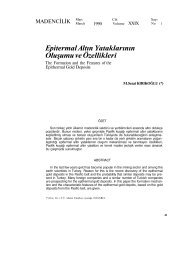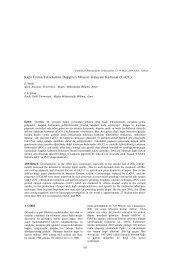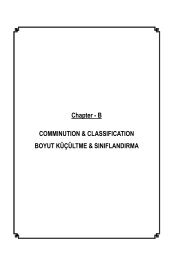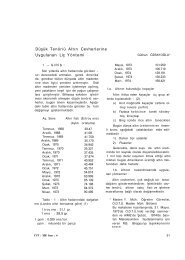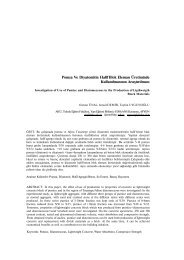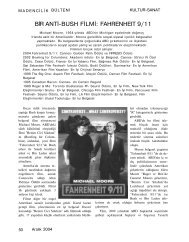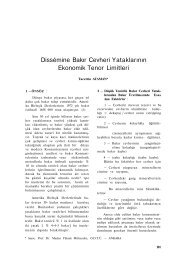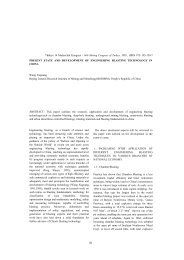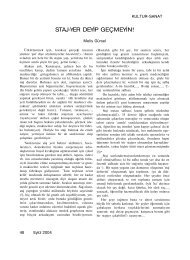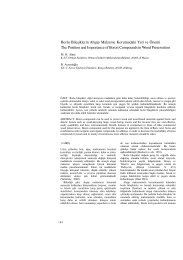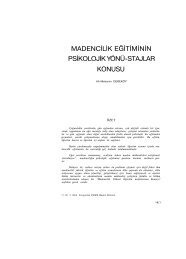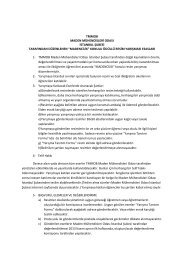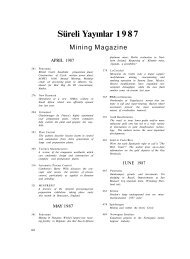A OPEN PIT MINING AÇIK OCAK MADENCİLİĞİ
A OPEN PIT MINING AÇIK OCAK MADENCİLİĞİ
A OPEN PIT MINING AÇIK OCAK MADENCİLİĞİ
You also want an ePaper? Increase the reach of your titles
YUMPU automatically turns print PDFs into web optimized ePapers that Google loves.
23 rd <br />
Figure 1 shows the procedure of the<br />
proposed method.<br />
There are three objectives on the base of<br />
sustainable development concepts:<br />
1. Maximizing social benefit<br />
2. Maximizing economical benefit<br />
3. Minimizing environmental impact<br />
In this paper, a three-objective model is<br />
developed to maximize the economic and<br />
social benefits and minimize the negative<br />
environmental impacts of the selected UPL.<br />
Table 1 gives a summary of the sustainable<br />
development indicators applied for UPL<br />
determination.<br />
Figure 1. The procedure of UPL<br />
determination based on sustainable<br />
development indicators<br />
Table 1. Sustainable development indicators<br />
Environmental<br />
Indicators<br />
Social<br />
Indicators<br />
Economical<br />
Indicators<br />
Reclamation cost<br />
Land use<br />
Stripping ratio (w/o)<br />
Specific energy used<br />
Mine life (year)<br />
Safety<br />
Resource efficiency<br />
Ore content<br />
Profit<br />
ore unit value of the pit<br />
The amount of these parameters<br />
(indicators) is determined for each possible<br />
UPL. Then the rate of these indicators is<br />
calculated for each case according to the<br />
characteristics of each possible UPL. The<br />
rate of each indicator is calculated through<br />
equation 1.<br />
x<br />
ij<br />
x<br />
i ,min<br />
I<br />
ij<br />
<br />
(1)<br />
x x<br />
i ,max<br />
i ,min<br />
For those indicators with negative impact,<br />
equation 2 is applied to calculate the rate.<br />
x<br />
i ,max<br />
x<br />
ij<br />
I<br />
ij<br />
<br />
(2)<br />
x x<br />
i ,max<br />
i ,min<br />
Where I<br />
ij<br />
is the rate of indicator i for the<br />
pit j, x<br />
ij<br />
, x<br />
i ,max<br />
, and x ,min<br />
is amount of<br />
parameter (indicators) i for the pit j,<br />
maximum amount of indicator i and<br />
minimum indicator i, respectively.<br />
Afterword, considering the principles of<br />
sustainable development, one must<br />
determine the importance and weight of<br />
these indicators ( w<br />
i<br />
in equation 3). This is a<br />
time consuming and case dependant process,<br />
and these weights should be determined<br />
carefully.<br />
Finally, the summation of all the<br />
indicators for each case shows the score of<br />
that particular case (equation 3).<br />
S w x , j indicates each pit (3)<br />
j i i<br />
Where S<br />
j<br />
is the final score of the pit j.<br />
Using the scores, one could determine the<br />
ranking of pits, and select a pit with the<br />
highest score. Next section provides an<br />
example to show the applicability of this<br />
procedure.<br />
2.2 Example<br />
In this section, the procedure described<br />
earlier is applied in an example to show the<br />
effectiveness of this method to determine a<br />
pit limit according to sustainable<br />
development requirements. Consider the<br />
block model given in figure 2.<br />
If the price of the product is 80 units, and<br />
the cost of mining and processing is 4 and 12<br />
respectively, then one could determine the<br />
block economic values and economic block<br />
model (figure 3).<br />
The mathematical model of UPL<br />
determination is given as equations 4-6.<br />
Equation 4 is the objective function and it<br />
tries to maximize the ore content of the pit.<br />
Equations 5 and 6 are constraints of the<br />
107



